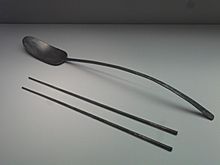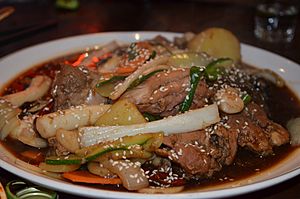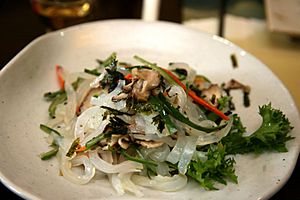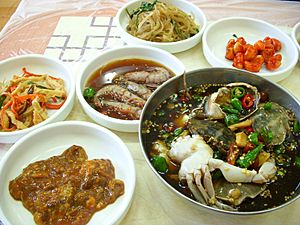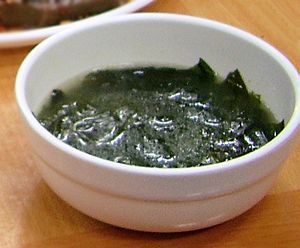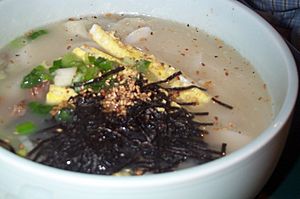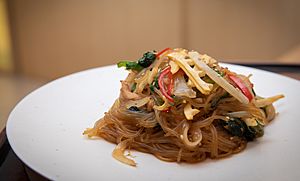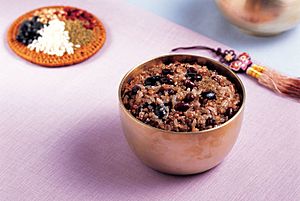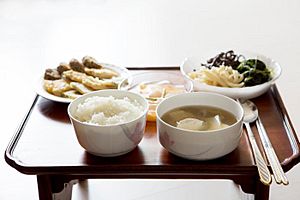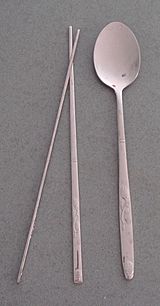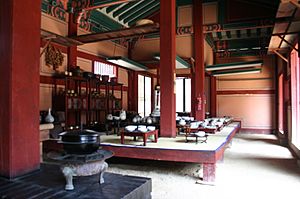Korean cuisine facts for kids
| Top - 0-9 A B C D E F G H I J K L M N O P Q R S T U V W X Y Z |
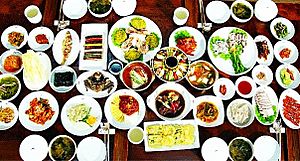
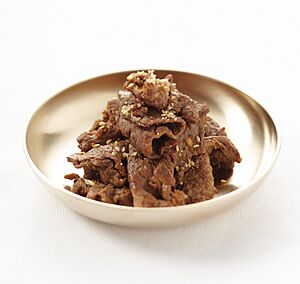


Korean cuisine is all about the delicious foods and cooking styles connected to Korean culture. This amazing food has changed a lot over hundreds of years as society and politics shifted. It started with ancient farming and nomadic traditions in Korea and southern Manchuria. Korean food shows how the natural environment and different cultural trends have mixed together.
Korean meals often feature rice, vegetables, seafood, and meat (especially in South Korea). You won't find much dairy in traditional Korean food. Meals are often named by how many side dishes (반찬; 飯饌; banchan) come with the steamed short-grain rice. Kimchi is almost always served! Some common ingredients are sesame oil, doenjang (a fermented bean paste), soy sauce, garlic, ginger, gochugaru (chili flakes), gochujang (spicy red chili paste), and napa cabbage.
The ingredients and dishes can be different depending on the region. Many local dishes have become popular all over the country. In the past, Korean royal court cuisine brought together all the special regional foods for the royal family. There are also special rules about how to eat Korean food, based on cultural etiquette.
Did you know that Kimjang, which is the process of making kimchi, is so important that it's on the UNESCO Intangible Heritage List?
History of Korean Food
Korean food has a long and interesting history, changing with the times.
Ancient Times: Early Farming and Food
In the Jeulmun pottery period (about 8000 to 1500 BCE), people hunted, fished, and gathered food. Later, they started farming a little. During the Mumun pottery period (starting 1500 BCE), farming really grew. New groups from the Liao River area brought new farming ideas. People grew millet, barley, wheat, beans, and rice. They also kept hunting and fishing. Old findings show that fermented beans were made back then. Contact with nomadic groups from the north helped people start raising animals.
Three Kingdoms Period: Food and Culture Grow
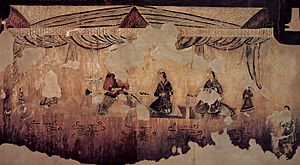
The Three Kingdoms period (57 BCE – 668 CE) was a time of fast cultural change. The kingdom of Goguryeo was in the north. Baekje was in the southwest, and Silla was in the southeast. Each area had its own special foods and customs. For example, Baekje was known for cold and fermented foods like kimchi. The spread of Buddhism and Confucianism from China in the 4th century CE started to change Korea's cultures.
The Goguryeo people were good at fermenting food. They are thought to have made the earliest kimchi.
Goryeo Period: New Foods Arrive
In the 13th century, the Mongols invaded Goryeo. Some traditional Korean foods we eat today came from this time. Dishes like mandu (dumplings), grilled meats, noodle dishes, and spices like black pepper all started during this period.
Joseon Period: Farming and New Crops
Farming improved a lot during the Joseon period. A rain gauge was even invented in the 15th century! In 1429, the government published books about farming. One famous book was Nongsa jikseol ("Straight Talk on Farming"), put together under King Sejong.
Later in the Joseon period, scholars looked outside Korea for new ideas to improve farming. Crops from the New World (like maize, sweet potatoes, chili peppers, tomatoes, peanuts, and squash) started to appear. These came through trade with China, Japan, Europe, and the Philippines. Potatoes and sweet potatoes were popular because they could grow in places where other crops couldn't.
The government also helped farming by building complex irrigation systems. This let farmers grow more food, not just for themselves but also to sell. Lower taxes for farmers also helped markets grow. By the 19th century, there were a thousand markets, which were places for trade and fun.
Towards the end of the Joseon period, Korea started trading more with Western countries, China, and Japan. In the 1860s, trade agreements led Korea to open its ports. This brought more cultural and food exchanges. Western missionaries brought new ingredients and dishes. Korean leaders learned about these new foods from foreign advisors. This time also saw new seasonings from Japan and alcoholic drinks from China.
Modern Korean Food: Changes and Growth
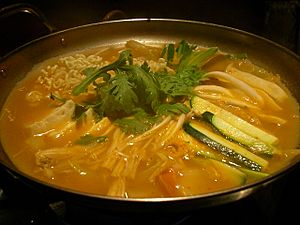
Japan occupied Korea from 1910 to 1945. Many Korean farms were used to support Japan's food supply. Rice production increased for the Japanese Empire's war efforts. Koreans, in turn, grew more other grains for themselves.
During the Japanese occupation, meals varied. Poorer Koreans often ate cheaper grains like millet and barley. Richer Koreans started eating Western foods like white bread. The occupation ended after Japan's defeat in World War II.
Korea faced more challenges during the Korean War (1950–1953) and the Cold War. This split the country into North Korea and South Korea. Food was still limited. The stew called budae jjigae, made with cheap meats like sausage and Spam, came from this time.
After the war, North and South Korea went in different directions. In the 1960s, South Korea began to industrialize. Farming improved with modern equipment. By the 1970s, food shortages lessened. People started eating more instant and processed foods. Meat consumption, especially pork and beef, grew a lot. This led to many bulgogi restaurants opening, making meat more common for middle-class families. Rice consumption decreased as people ate more bread and noodles. In 2009, the South Korean government started a program to promote Korean food around the world.
Types of Korean Food
Korean food uses many different ingredients and cooking styles.
Grains: The Heart of Korean Meals

Grains have always been super important in the Korean diet. Old stories about how Korean kingdoms started often involve grains. For example, a myth says Jumong, who founded Goguryeo, got barley seeds from two doves sent by his mother.
In ancient times, grains like barley and millet were the main foods. Wheat, sorghum, and buckwheat were also eaten. Rice wasn't originally from Korea, and millet was probably eaten more before rice farming became popular. Rice became the top grain during the Three Kingdoms period, especially in the southern kingdoms of Silla and Baekje. Rice was so valuable in Silla that it was used to pay taxes!
When rice first came to Korea, it was very expensive. So, it was often mixed with other grains to make it last longer. This is still done in dishes like boribap (rice with barley) and kongbap (rice with beans). White rice (rice with the outer layer removed) has been the favorite since it was introduced. The traditional way to cook rice is in an iron pot called a sot. This method dates back to at least the Goryeo period, and these pots have been found in Silla tombs. The sot is still used today.
Rice is used for many things besides just a bowl of plain rice. It's often ground into flour to make tteok (rice cakes), with over two hundred types! It's also cooked into a thick porridge called juk or mieum, mixed with other grains, meat, or seafood. Koreans also make many rice wines. Grains have also been used for centuries to make misu and misu-garu, which are drinks made from grain powder, sometimes used as meal replacements.
Fruits: Sweet Treats from Nature
Korea has many different climates, so it grows lots of cultivated and wild fruits. Asian pears, apples, melons, and berries are common in summer and fall.
Legumes: Beans and More

Legumes (like beans) have been important crops in Korea for a long time. Old findings show that soybeans were grown for food around 1000–900 BCE. Soybeans are still used to make dubu (tofu), and soybean sprouts are cooked as a vegetable (kongnamul). Whole soybeans are seasoned and served as a side dish. They are also made into soy milk, which is the base for kongguksu noodles. A leftover from soy milk making is biji, used to thicken stews. Soybeans are also the main ingredient for fermented sauces like doenjang (soybean paste), ganjang (soy sauce), and gochujang (chili paste).
Nokdu (mung bean) is also common. Sukju namuls (mung bean sprouts) are often served as a side dish, cooked with sesame oil, garlic, and salt. Ground nokdu makes a porridge called nokdujuk, eaten for nutrition. A popular snack, bindaetteok (mung bean pancake), is made with ground nokdu. Starch from nokdu is used to make clear dangmyeon (cellophane noodles), which are key in japchae (a salad-like dish) and sundae (blood sausage). This starch also makes jelly-like foods like nokdumuk. These jellies are usually seasoned with soy sauce and sesame oil.
Azuki beans have been grown since ancient times. They are often eaten as patbap (rice mixed with beans) or as a filling for tteok (rice cake). A porridge made with azuki beans, called patjuk, is eaten in winter. On Dongjinal (December 22), Koreans eat donji patjuk with saealsim (small glutinous rice balls). It's believed that patjuk can scare away bad spirits.
Condiments and Seasonings: Adding Flavor
Korean Condiments are either fermented or not. Fermented ones include ganjang (soy sauce), doenjang (bean paste), gochujang (chili paste), and vinegars. Non-fermented spices include red pepper, black pepper, garlic, onion, ginger, and scallions.
Gochujang: The Spicy Paste
Gochujang is a famous fermented bean paste. It has red pepper powder, soybean powder, and rice flour, making it a spicy paste. It can be added to most dishes as a seasoning or used as a dipping sauce.
Many other sauces come from jang (fermented bean paste). These include doenjang (soybean and salt water), kanjang (soybeans, water, and salt), chogochujang (gochujang with vinegar), and jeotgal (a mix of other jangs and seafood).
Vegetables like cucumbers, carrots, and cabbage are often dipped in gochujang. It's also a common seasoning for Korean barbecue, like pork and beef. A popular snack, Bibimbap, which has rice, spinach, radish, and bean sprouts, is often eaten with gochujang. Another popular dish with gochujang is tteokbokki.
In the past, gochujang was thought to help people with colds or tiredness. Some studies even suggest red peppers might help fight obesity and diabetes. Gochujang is added to many foods to boost their nutrition.
Meat: From Hunting to Grilling
In ancient times, most meat in Korea probably came from hunting and fishing. Later, people started raising livestock on a small scale. Meat was eaten roasted or in soups. People near the ocean ate more fish, while those inland ate more meat.
Beef: A Special Treat
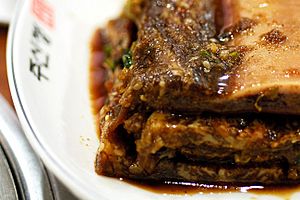
Beef is highly valued in Korea. Cattle were important farm animals, sometimes seen as part of the family. Beef is cooked in many ways today, like roasting, grilling (gui), or boiling in soups. Beef can also be dried into yukpo.
Because cattle were so important for farming, eating beef was not common. Pork and seafood were eaten more often. During the Goryeo period, Buddhist rulers even banned eating beef. The Mongols lifted this ban in the 13th century and encouraged beef farming. This continued into the Joseon period. Only in the late 20th century did beef become a regular part of meals.
Chicken: A Cultural Symbol
Chicken has been an important protein in Korea for a long time. An old story says the birth of Kim Alji, who founded the Kim family of Gyeongju, was announced by a white chicken's cry. This shows how important chickens were in Korean culture. Chicken is often roasted, braised with vegetables, or put in soups. All parts of the chicken are used, including the gizzard, liver, and feet. Young chickens are braised with ginseng in special soups called samgyetang, eaten in summer to fight the heat. Chicken feet, called dakbal, are often roasted with a spicy gochujang sauce and served as a snack with alcoholic drinks like soju.
Pork: A Common Protein

Pork has also been a key meat in Korea since ancient times. People used to avoid eating pork with certain foods like Chinese bellflower or lotus root, thinking it would cause stomach problems. All parts of the pig are used in Korean cooking, including the head and internal organs. Koreans cook these parts by steaming, stewing, boiling, and smoking. Koreans especially love grilled pork belly, called samgyeopsal.
Fish and Seafood: From the Coasts
Fish and shellfish are a big part of Korean cuisine because Korea is surrounded by oceans. Records from the 12th century show that common people mostly ate fish and shellfish like shrimp, clams, oysters, and abalone. Sheep and hogs were mostly for the upper class.
Both fresh and saltwater fish are popular. They are served raw, grilled, broiled, dried, or in soups and stews. Common grilled fish include mackerel and hairtail. Smaller fish, shrimp, and squid can be salted and fermented as jeotgal. Fish can also be dried to last longer and be shipped far away. Dried anchovies and kelp are used to make soup stocks.
Shellfish are eaten in many ways. They can be used for broth, eaten raw with chogochujang (a mix of gochujang and vinegar), or added to many dishes. Raw oysters and other seafood can be used in kimchi to add flavor. Salted baby shrimp, called saeujeot, are used to season some types of kimchi. Large shrimp are often grilled as daeha gui or dried and mixed with vegetables and rice. Mollusks like octopus, cuttlefish, and squid are also eaten.
Vegetables: Fresh and Healthy
Korean cuisine uses a huge variety of vegetables. They are often served raw in salads or pickles, or cooked in stews, stir-fries, and other hot dishes. Common vegetables include Korean radish, napa cabbage, cucumber, potato, spinach, bean sprouts, scallions, garlic, chili peppers, seaweed, and mushrooms. Wild greens like chwinamul and bracken fern shoots (gosari) are also popular. Traditional medicinal herbs like ginseng and lingzhi mushroom are often used in cooking, for example, in samgyetang.
Medicinal Foods: Eating for Health
Medicinal food (boyangshik) refers to special foods eaten for their health benefits. These are especially popular during the hottest summer days, called sambok. Eating hot foods is believed to restore energy and strength lost in the summer heat. Common boyangshik include ginseng, chicken, black goat, abalone, and beef bone soups.
Samgyetang: Summer's Healing Soup
Samgyetang is a chicken ginseng soup. It's traditionally eaten during Boknal days, the hottest days of summer. Koreans have a custom called Iyeolchiyeol, which means "controlling heat with heat." So, Samgyetang is a favorite energy-boosting food. It's common to eat it on sambok days (Chobok, Jungbok, and Malbok), which are believed to be the hottest days in Korea.
Popular Korean Dishes
Korean foods are generally grouped into "main staple foods," "side dishes," and "desserts." Main dishes are made from grains like bap (a bowl of rice), juk (porridge), and guksu (noodles).
Many Korean banchan (side dishes) use fermentation for flavor and to keep them fresh. This gives them a tangy, salty, and spicy taste. Some cities are famous for certain dishes, like Jeonju for bibimbap. Restaurants often use these famous names.
Soups and Stews: Essential to Every Meal
Soups are a common part of any Korean meal. Unlike other cultures, in Korea, soup is served with the main course, not just at the beginning or end. Soups called guk are often made with meats, shellfish, and vegetables. More formal soups are called tang, and they can be the main dish. Jjigae are thicker, more heavily seasoned soups or stews.
Some popular types of soups are:
- Malgeunguk are clear soups flavored with ganjang (soy sauce). They can have small amounts of boiled meat, fresh or dried seafood, or vegetables.
- Doenjang-guk are seasoned with doenjang (bean paste). Common ingredients include clams, dried anchovies, and shrimp. For a spicier soup, gochujang is added.
- Tteok-guk is a rice cake soup, often made with thin slices of garae-tteok (long, cylindrical rice cakes) and beef broth. It's eaten on New Year's Day because Koreans believe eating a bowl makes you one year older! The oval shape of the rice cakes is thought to bring good fortune, like old Korean coins.
- Gomguk or gomtang are rich soups made by boiling beef bones or cartilage for a long time. All parts of the beef are used to create a rich soup with fat, marrow, and gelatin. Salt is usually the only seasoning.
- Naengguk are cold soups, usually eaten in summer to cool down. They are lightly seasoned with ganjang and sesame oil.
Stews, called jjigae, are often shared. Jjigae is usually cooked and served in the same earthenware pot (ttukbaegi). The most common is doenjang jjigae, a soybean paste stew with many variations. Common ingredients include vegetables, fish, and tofu. Other popular jjigae include kimchi jjigae (with kimchi) or sundubu jjigae (with tofu).
- Miyeok-guk is a soup made from dried seaweed. It's usually eaten on Koreans' birthdays. It's also traditionally consumed by mothers after giving birth. This tradition started in Goguryeo.
Kimchi: Korea's Signature Dish

Kimchi refers to fermented vegetable dishes, most often made with napa cabbage, Korean radish, or cucumber. There are endless varieties with regional differences. It's served as a side dish or cooked into soups and rice dishes. In the past, Koreans buried kimchi jars in the ground to store it for winter. These were kept in traditional mud pots called jangdokdae. Today, special kimchi refrigerators and store-bought kimchi are common. Kimchi is low in calories and fat, and has no cholesterol. It's rich in vitamins (A, B, C, K) and minerals (calcium, iron, phosphorus, selenium). It also contains healthy bacteria, like those found in yogurt. In 2021, Koreans ate a lot of kimchi, with the average person eating about 88.3 grams daily.
Noodles: Long and Delicious
Noodles in Korean cuisine are called guksu or myeon. Wheat noodles weren't an everyday food until 1945 because wheat was less common than other crops. Wheat noodles (milguksu) were special for birthdays or weddings. Their long shape was thought to bring long life and lasting marriage.
Traditional Korean noodle dishes include onmyeon (noodles with hot clear broth), naengmyeon (cold buckwheat noodles), bibim guksu (cold mixed noodles), kalguksu (knife-cut noodles), kongguksu (noodles with cold soybean broth), and japchae (cellophane noodles with vegetables).
- Jajangmyeon is a very popular Korean-Chinese noodle dish, often ordered as fast takeout food. It has a black bean sauce, usually fried with diced pork or seafood and vegetables like zucchini and potatoes.
- Ramyeon refers to Korean instant noodles, similar to ramen.
- Japchae is a popular dish made by cooking vegetables, mushrooms, and meat, then mixing them. It's often enjoyed on special occasions. There are versions with and without glass noodles. The original recipe didn't have glass noodles. It's a very nutritious dish because it uses many different ingredients.
Banchan: Side Dishes Galore
Banchan is the general term for side dishes in Korean cuisine. Soups and stews are not considered banchan.
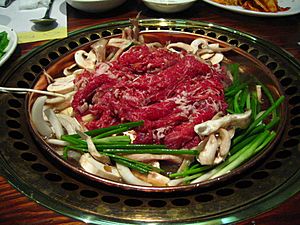
Gui are grilled dishes, usually with meat or fish, but sometimes grilled vegetables. In traditional restaurants, meats are cooked at the center of the table over a charcoal grill. They are surrounded by various banchan and individual rice bowls. The cooked meat is cut into small pieces and wrapped in fresh lettuce leaves with rice, garlic, ssamjang (a mix of gochujang and dwenjang), and other seasonings.
Jjim and seon are terms for steamed or boiled dishes. Jjim uses marinated meat or seafood, while seon uses vegetables stuffed with fillings.
Hoe (raw dishes) usually refers to saengseonhweh (raw fish dishes). It's dipped in gochujang or soy sauce with wasabi, and served with lettuce or perilla leaves.
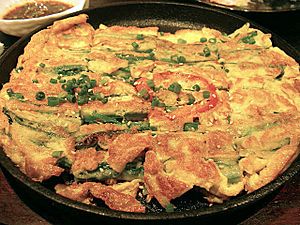
Jeon (or buchimgae) is a Korean savory pancake. Chopped kimchi or seafood is mixed into a flour batter and pan-fried. This dish is typically dipped in a mixture of soy sauce, vinegar, and red pepper powder. It can be served as an appetizer or a side dish.
There are also sweet versions called Hwajeon, which are flower pancakes.
Namul refers to seasoned vegetables. Saengchae are fresh, raw vegetables, often seasoned with vinegar, chili pepper powder, and salt for a tangy taste. Sukchae are blanched (quickly boiled) and seasoned with soy sauce, sesame oil, chopped garlic, or chili pepper powder.
Holiday Foods
Special holidays in Korea have their own traditional foods.
Songpyeon: Chuseok's Rice Cakes
Songpyeon is a Korean rice cake eaten during Chuseok (Korean Thanksgiving) to show thanks to ancestors. Records of Songpyeon go back to the 17th century. Originally, they were simple rice cakes steamed with pine needles. Later, fillings like red beans, pine nuts, walnuts, ginger, and cinnamon were added. Different regions have their own Songpyeon varieties, like potato songpyeon in mountainous areas or shellfish songpyeon near the coast.
Ogok-bap: Five-Grain Rice
Ogok-bap means "five rice dish." It's made with rice mixed with glutinous rice, cornstarch, red beans, perilla, and soybeans. Eating these grains is believed to bring good health and a good year, chasing away bad luck and bringing happiness.
Sweets and Desserts

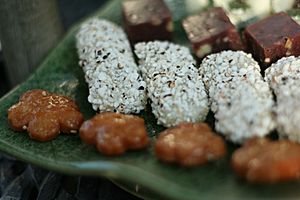
Traditional rice cakes, tteok, and Korean sweets, hangwa, are eaten as treats during holidays and festivals. Tteok includes all kinds of rice cakes made from pounded rice or glutinous rice. They can be filled or covered with sweet pastes like mung bean, red bean, or sesame, or with honey, pine nuts, or jujubes. Tteok is usually served as a dessert or snack. Songpyeon is a chewy, stuffed tteok for Chuseok. Yaksik is a sweet rice cake with glutinous rice, chestnuts, pine nuts, and jujubes. Chapssaltteok is a tteok filled with sweet bean paste.
Hangwa is a general term for all types of traditional Korean sweets. They are mainly made from grain flour, honey, yeot (a traditional candy), and sugar, or from fruits and edible roots. Hangwa includes fried sweets (yumilgwa), boiled fruits (suksilgwa), jellies (gwapyeon), and tea snacks (dasik). Yumilgwa are fried dough pieces like maejakgwa and yakgwa. Yakgwa, meaning "medicinal confectionery," is a flower-shaped biscuit made with honey, sesame oil, and wheat flour.
Suksilgwa is made by boiling fruits, ginger, or nuts, then shaping them. Gwapyeon is a jelly-like sweet made by boiling sour fruits, starch, and sugar. Dasik, meaning "eatery for tea," is made by kneading rice flour, honey, and flours from nuts or herbs. Jeonggwa is made by boiling fruits, plant roots, and seeds in honey or sugar. It's similar to jam. Yeot is a traditional Korean candy, liquid or solid, made from steamed grains like rice or corn.
Yugwa and Yakgwa are traditional desserts enjoyed during Chuseok, weddings, or 60th birthdays.
Regional Korean Food Styles
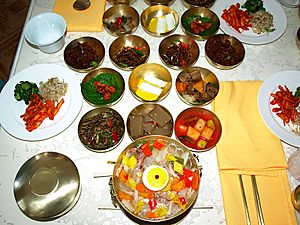
Korean regional cuisines have local specialties and unique styles. These differences come from the historical boundaries of the provinces where these food traditions were kept alive.
Korea was once divided into eight provinces. The northern region included Hamgyeong, Pyeongan, and Hwanghae Provinces. The central region had Gyeonggi, Chungcheong, and Gangwon Provinces. Gyeongsang and Jeolla Provinces made up the southern region.
In the past, transportation was not good, so each region kept its own tastes and cooking methods. Differences in climate and farming also led to different local foods. Today, with modern transport and foreign foods, Korean regional cuisines have started to mix. However, many unique traditional dishes are still passed down through generations.
Buddhist Temple Food

Korean temple cuisine started in Buddhist temples. Since Buddhism came to Korea, Buddhist traditions have greatly influenced Korean food. During the Silla period, chalbap (glutinous rice), yakgwa (fried dessert), and yumilgwa (fried rice snack) were offered at Buddhist altars. These later became types of hangwa (traditional Korean sweets). During the Goryeo period, sangchu ssam (lettuce wraps) and yaksik were developed. Since the Joseon dynasty, Buddhist cuisine has become well-known in different regions and temples.
Interestingly, royal court cuisine is connected to temple food. In the past, royal palace cooks who became old would leave the palace and sometimes become nuns in Buddhist temples. This led to royal cooking techniques and recipes being mixed into Buddhist cuisine.
Vegetarian Food in Korea
Vegetarian cooking in Korea is linked to the Buddhist traditions that influenced Korean culture. There are many vegetarian restaurants in Korea. Most have buffets with cold food, and vegetarian kimchi and tofu are main features. Bibimbap is a common vegan dish. Menus change with the seasons. Wine without alcohol and fine teas are also served. The Korean tea ceremony is suitable for all vegetarians and vegans, and it also started with Buddhist influences. All food is eaten with metal chopsticks and a long-handled shallow spoon, together called sujeo.
Street Food: Quick and Tasty Bites
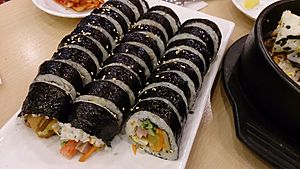
In South Korea, you can buy inexpensive food from pojangmacha (street carts) during the day. Customers can eat standing or take their food home. At night, pojangmacha become small tents selling food, drinks, and alcoholic beverages.
Seasonal street foods include hotteok (sweet pancakes) and bungeoppang (fish-shaped pastries), enjoyed in autumn and winter. Gyeran-ppang (egg bread) and hoppang (steamed buns) are also popular in winter.
Other common street foods include gimbap, tteokbokki (spicy rice cakes), sundae (blood sausage), twigim (fried snacks), and eomuk (fish cakes). Dak-kkochi (skewered chicken grilled in sauces) is also popular. Beondegi (silkworm pupae) and dalgona/ppopgi (sugar candy) are original street foods many people have enjoyed since childhood.
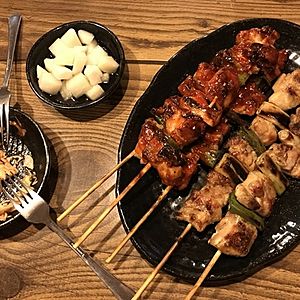
Dining Etiquette: How to Eat in Korea
Dining rules in Korea come from the Confucian ideas of the Joseon period. Old guidebooks, like Sasojeol (1775), gave advice on how to eat politely. For example, it said not to talk about gross things at the table or eat too fast or too slow. It also said not to throw chopsticks or make noise with spoons.
One important rule is that younger people should not pick up their chopsticks or start eating before the elders or guests at the table. They also shouldn't finish eating before the elders or guests.
In Korea, unlike in China or Japan, you don't lift your rice or soup bowl from the table when eating it. This is because each person gets a metal spoon along with chopsticks, called sujeo. The spoon is used for rice and soups. There are also rules for sharing side dishes: don't pick through the dishes for certain items, and make sure your spoon is clean when you use it for shared bowls. After the meal, you should cover your mouth when using a toothpick.
The table setup is also important. From left to right, you'll find the rice bowl, then the spoon, then the chopsticks. Hot foods are placed on the right side of the table, and cold foods on the left. Soup and stews stay on the right. Vegetables and rice are on the left. Kimchi is at the back, and sauces are at the front.
Royal Court Cuisine: Food for Kings and Queens

The food of the royal palace, called gungjung eumsik, showed how rich and fancy the past rulers of Korea were. Even in the Silla kingdom, there was a man-made lake (Anapji Lake) with pavilions just for grand banquets.
Royal cuisine brought together the best foods from all regions. The finest local specialties and delicacies were sent to the palace. The royal family's meals didn't just follow the seasons like commoners' meals. Instead, they changed a lot day-to-day. Each of the eight provinces sent ingredients to the palace every month, giving the cooks a wide variety of foods.
Food was very important during the Joseon period. Special government jobs were created just for getting and preparing food and drinks for the royal court. There were also hundreds of slaves and women who worked in the palace making things like tofu, liquor, tea, and tteok (rice cakes). The women were the main cooks for the royal palace. They were divided into special groups, like the "bureau of special foods" or the "bureau of cooking foods."
The royal palace usually served five meals a day during the Joseon period. Three were full meals, and two were lighter. The first meal, mieumsang, was served at sunrise. It was a rice porridge with ingredients like abalone, mushrooms, or pine nuts. This porridge was thought to give the king and queen energy for the day.
The sura were the main meals, served at 10 AM and between 6 and 7 PM. These meals were usually set on three tables (surasang). They included two types of rice, two types of soup, two types of stew (jjigae), a meat stew (jjim), a casserole (jeongol), three types of kimchi, three types of jang (sauces), and twelve side dishes. The meals were served in a special room called suragan. Three palace servant women, called sura sanggung, attended the king and queen. They would check the dishes for poison before serving.
Banquets were held for special occasions like royal birthdays, weddings, and national festivals. Banquet food was served on individual tables, with different dishes depending on the person's rank. Main dishes were based on seasonal foods. A typical banquet might include sinseollo (a fancy hot pot), jeon (pancakes), and nengmyun (cold noodles). Yaksik was a favorite banquet dessert.
Health Benefits of Korean Food
Traditional Korean food, or Hansik, is often linked to good health. While modern Korean diets include more Western foods, many still believe in the healing power of Hansik. Vegetables and fermented foods are healthy, and Hansik has many of them. A basic Hansik meal, called three Cheopbansang, includes soup, Kimchi, and multigrain rice. Fermented soybean paste (Doenjang) in soups and fermented red chili paste (Gochujang) in kimchi add health benefits.
Certain foods are eaten to fight summer heat or winter cold, regain strength after illness, or for general health. Cold noodles (Naengmyeon) are popular in summer to cool down. Likewise, ginseng chicken soup (Samgyetang) is often eaten in summer to reduce heat exhaustion and boost energy.
Eating a traditional Korean diet may lower the risk of some health issues like obesity and metabolic syndrome. This can lead to a decrease in body mass index (BMI), body fat, and bad cholesterol. Fermented foods like kimchi and doenjang contain probiotics, which can boost your immune system and reduce allergies like asthma. It may also lower the risk of heart and chronic metabolic diseases like high blood pressure and diabetes.
The probiotics in kimchi are linked to anti-inflammatory effects and improved gut health. However, kimchi is made with a lot of salt, and about 20% of sodium intake comes from kimchi. Some studies found a higher risk of stomach cancer with very frequent or high kimchi consumption. Like other salted foods, eating kimchi in moderation can give you the most health benefits.
See also
 In Spanish: Gastronomía de Corea para niños
In Spanish: Gastronomía de Corea para niños
- Culture of South Korea
- Delivery culture in South Korea
- Korean New Year
- Banchan
- Hanjeongsik
- North Korean cuisine
- South Korean cuisine
- List of Korean desserts
- List of Korean dishes
- List of Korean drinks
- List of Korean restaurants
- List of oldest restaurants in South Korea


